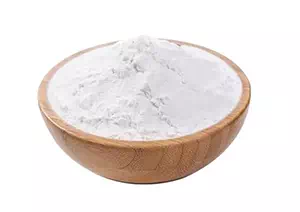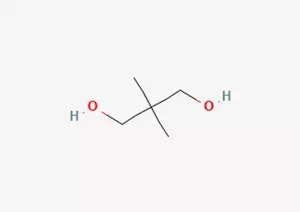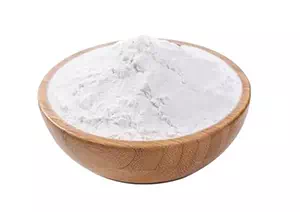All Categories



neopentyl glycol CAS 126-30-7, neopentyl glycol, CAS 126-30-7
In the vast world of chemistry, there is a substance that attracts much attention - neopentyl glycol. Its full name is 2, 2-dimethyl-1, 3-propanediol. For the convenience of expression and memory, people often simply call it NPG. Judging from its chemical formula C5H12O2, it has a unique composition structure and is a typical neopentyl structure diol.
CAS : 126-30-7
Formula : C5H12O2
Mol. wt. : 104.15
EINECS : 204-781-0
Chemical Name | Neopentyl Glycol |
Other Name | 2,2-Dimethyl-1,3-propanediol |
CAS | 126-30-7 |
EINECS | 204-781-0 |
Type | Pigments and dyes; Pharmaceutical raw materials; Organic raw materials |
Molecular Formula | C5H12O2 |
Molecular Weight | 104.15 |

Melting point | 126-128 °C |
Boiling point | 208 °C |
density | 1.06 |
vapor density | 3.6 (vs air) |
vapor pressure | <0.8 mm Hg ( 20 °C) |
refractive index | 1.4406 (estimate) |
Fp | 107 °C |
storage temp. | Inert atmosphere,Room Temperature |
solubility | 830g/l |
form | Crystalline Chunks |
In the vast world of chemistry, there is a substance that attracts much attention - neopentyl glycol. Its full name is 2, 2-dimethyl-1, 3-propanediol. For the convenience of expression and memory, people often simply call it NPG. Judging from its chemical formula C5H12O2, it has a unique composition structure and is a typical neopentyl structure diol.
When we observe the state of neopentyl glycol at room temperature, we will find that it presents the form of a white crystalline solid. When you get close and smell it, there is no special odor at all. This is its odorless characteristic. Meanwhile, it also has the characteristic of absorbing moisture, just like a tiny "moisture collector", capable of absorbing moisture from the surrounding environment.
In terms of solubility, neopentyl glycol exhibits rather unique properties. It is highly soluble in water, just as naturally and smoothly as sugar cubes dissolve in water. It can also easily blend with solvents such as ethers, low alcohols and low ketones, demonstrating good compatibility. However, when it comes to aliphatic compounds, it appears somewhat "reserved" and is difficult to dissolve in them.
The significance of neopentyl glycol in the field of chemical engineering should not be underestimated. The polyester resin synthesized from it is like an all-round "guardian", with excellent chemical stability. Whether facing harsh chemical environments such as strong acids and strong alkalis or in complex chemical reactions, it can maintain its stability and is not easily disturbed by external factors. Its corrosion resistance is also quite excellent, just like putting on a solid "protective armor" for the relevant materials, which can effectively resist the invasion of various corrosive factors. Moreover, it also has hydrolysis resistance. Even in a humid environment or when in contact with water, it can still maintain its own performance and will not easily undergo hydrolysis reactions. For this reason, this polyester resin synthesized from neopentyl glycol is widely used in many industries such as chemical engineering, plastics, coatings, textiles, and petroleum, and has become an indispensable and important component in these industries.
Neopentyl glycol (NPG), as a unique polyol, stands out among numerous chemical substances. Due to its high chemical and thermal stability, it has excellent performance advantages in many end-use applications, like a brilliant pearl, shining brightly in related fields. It is indeed a unique diol that demonstrates astonishingly excellent performance in many end uses. And the root cause of these remarkable advantages lies precisely in its unique chemical structure.
Carefully exploring its chemical structure, we will find that the hydroxyl group is located on the primary carbon atom. This special position enables it to react with the corresponding substances rapidly like an agile hunter during esterification reactions, achieving an efficient esterification process. Furthermore, the two methyl groups on the α -carbon atom (instead of the usual two hydrogen atoms) are the "magic code" that endows neopentyl glycol and its derivatives with high chemical and thermal stability. These two methyl groups are like loyal guardians, safeguarding the stability of the entire molecular structure and enabling it to maintain outstanding performance under various complex conditions.

Neopentyl glycol, as a multifunctional compound that holds an important position in the chemical industry, has a remarkable range of applications. It is not only a key plasticizer for the production of unsaturated polyester materials, effectively enhancing the flexibility and processing performance of the materials, but also widely used in the manufacturing of oil-free alkyd resins, endowing the products with excellent physical and chemical stability. In the field of polyurethane, neopentyl glycol, as an important raw material for foams and elastomers, plays a crucial role in improving the elasticity, wear resistance and weather resistance of products. In addition, it is also used as an additive for high-grade lubricants and other fine chemicals. Through its unique chemical properties, it significantly enhances the performance and quality of products.
Neopentyl glycol, with its unique solvent properties, demonstrates extraordinary capabilities in the separation process of aromatic hydrocarbons and cycloalkyl hydrocarbons, and has become an indispensable separator in this field. Its outstanding chemical stability enables neopentyl glycol to maintain its stability and effectiveness when exposed to water, various chemical substances and natural weathering, and is not easily disturbed by the external environment. In the coating industry, amino retort varnish based on neopentyl glycol is highly favored due to its excellent light retention and anti-yellowing ability, and it can maintain the brightness and luster of the coating for a long time.
In addition to the above applications, neopentyl glycol is also an ideal choice for manufacturing basic materials such as preventive agents, stabilizers and pesticides. Their unique chemical structure and reactivity enable these products to exert more outstanding efficacy in their respective application fields. For example, in the field of new drug synthesis, using neopentyl glycol (NPG) and ethylene glycol as raw materials, tetraphenylporphyrin with significant biological activities can be successfully synthesized. Meanwhile, it is also used in the preparation process of bryophytin 2, the regulatory authority for the synthesis of healthy protein kinases, further expanding its application scope in the field of biomedicine.
Specifically in terms of chemical synthesis,2, 2-dimethyl-1, 3-propanediol (that is, an isomer or related compound of neopentyl glycol) has demonstrated its powerful synthetic ability even more. It can be used as a raw material to synthesize a variety of compounds with specific functions through a series of delicate chemical reactions. Such as 2, 2-dimethyl-1, 3-cyclochlorophosphate propylene glycol,2, 2-dimethyl-1, 3-cyclophenylphosphonate propylene glycol, etc. These compounds have broad application prospects in multiple fields such as medicine, pesticides, and dyes. Furthermore, neopentyl glycol is also involved in more complex organic synthesis processes. Synthesize (1',3'-(2',2'-dimethylpropylene) 2-ioDO-3-octyl-5-thienyl boric acid, cyclic carbonic acid and 2 2-dimethyl-1 compared with bis (cyclic-2 2 - dimethyltrimethylenephosphite), etc., these synthetic products tend to have more unique chemical properties and application value, has injected new vitality to the development of chemical industry.
* Prompt reply and 24 hours online, professional team to provide best price and high quality product.
* Sample testing support.
* Every batch of products will be tested to ensureits quality.
*The packing also can be according the customers` requirment.
*Any inquiries will be replied within 24 hours.
*we provide Commerical Invoice, Packing List, Bill of loading, COA , Health certificate and Origin certificate. If your markets have any special requirements, let us know.